Aurora Borealis or also referred to as Northern Lights occur when the charged particles of the solar wind enter the earths upper atmosphere. Colorful layers of light are visible along the earths magnetic field lines creating the typical light curtains. A truly magical light show in the sky which can be best observed in the very Northern Regions of our planet. You will find the same phenomenon in the Southern Hemisphere - there they are called Aurora Australis.
Aurora Borealis oder auch Nordlichter / Polarlichter genannt entstehen wenn die aufgeladenen Teilchen des Sonnenwindes in die oberen Schichten der Erdatmosphäre eintreten. Entlang der Feldlinien des Erdmagnetfelds entstehen dann die typischen Lichtvorhänge. Eine fantastische Lichtershow am Himmel, die am besten in nördlichen Regionen unseres Planeten beobachtet werden kann. Das Phänomen ist auch auf der südlichen Erdhalbkugel zu beobachten, dort trägt es den Namen Aurora Australis.
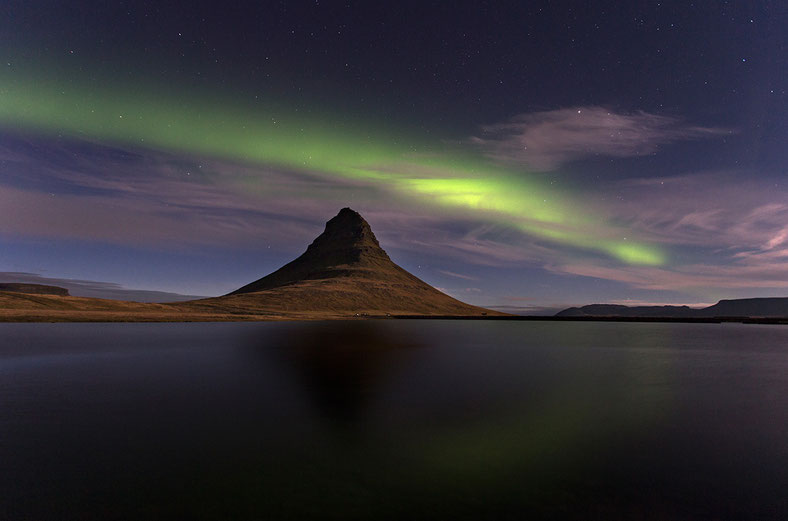
Aurora Borealis above Mt. Kirkjufell (463 m) close to Grundarfjörður on the Snæfellsnes peninsula, Iceland. Including landscape details in your shot can make the scene even more interesting.
Aurora Borealis über dem Berg Kirkjufell (463 m) in der Nähe von Grundarfjörður auf der isländischen Halbinsel Snæfellsnes. Das Mit-einbeziehen von landschaftlichen Details kann die Aufnahme noch zusätzlich aufwerten.
Exposure Details / Aufnahmedaten
Canon EOS 1Dx
Canon 17-40mm EF 1:4 L USM @ 17mm
13 s
f/5
ISO 800
Tripod / Stativ
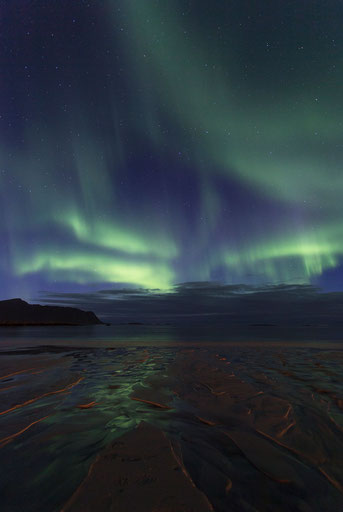
Try to include some foreground structures to create additional depth in your picture.
Here you can see the Aurora reflecting in the sand at Ramberg Beach on the Lofoten
Islands in Norway. When taking pictures with tripod on soft surfaces (beach sand) ensure
that your tripod stays stable and does not move during exposure. Use special tripod feet or push the tripod deep enough in the sand that it will not drift into the sand during exposure.
Um mehr Tiefe im Bild zu erzeugen bietet es sich an den Vordergrund mit ins Bild einzu-
beziehen - hier die Sandstrukturen am Ramberg Beach auf den Lofoten in Norwegen.
Bei Belichtungen mit dem Stativ in weichem Untergrund (Sand) ist es wichtig sicherzustellen,
dass das Stativ nicht einsinken kann - hierzu das Stativ fest genug in den Sand eindrücken, oder spezielle Stativfüße nutzen um das Einsinken im Sand zu verhindern.
Exposure Details / Aufnahmedaten
Canon EOS 1Dx
Canon 17-40mm EF 1:4 L USM @ 17mm
10 s
f/4
ISO 640
Tripod / Stativ
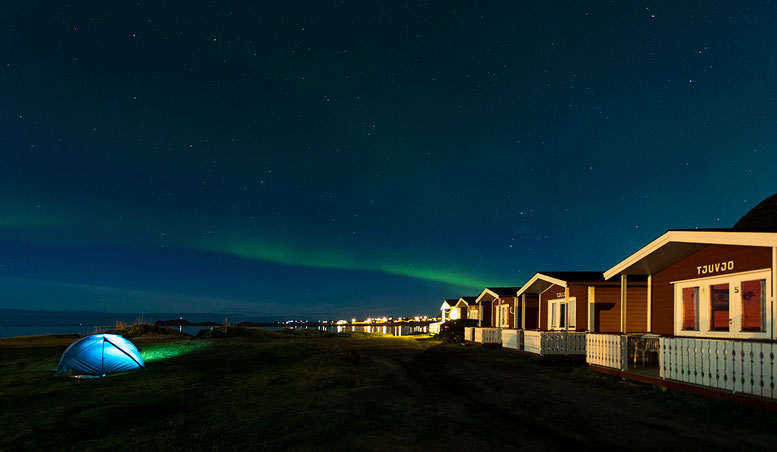
Ramberg Beach Campground with an illuminated tent and wooden cabins created a great foreground for this Aurora Shot.
Das beleuchtete Zelt und die hölzernen Blockhäuser auf dem Ramberg Campingplatz boten einen fantastischen Vordergrund für diese Aufnahme des Nordlichtes.
Exposure Details / Aufnahmedaten
Canon EOS 1Dx
Canon 17-40mm EF 1:4 L USM @ 17mm
10 s
f/4
ISO 1000
Tripod / Stativ
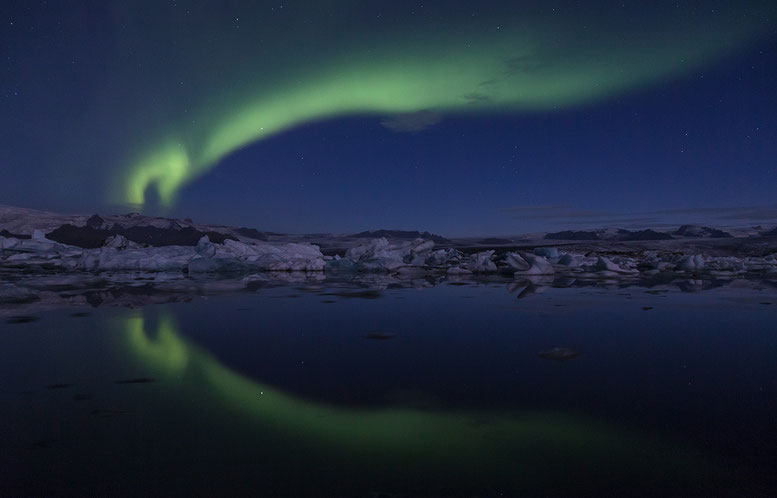
Smooth water surfaces create fantastic reflections of the Aurora. Here you can see the Jökulsárlón Glacier Lagoon at the southern edge of the Vatnajökull glacier on Iceland.
Glatte Wasseroberflächen eröffnen die Möglichkeit fantastische Spiegelungen der Aurora aufnehmen zu können. Hier am Jökulsárlón, einer Gletscherlagune am Südrand des Vatnajökull Gletschers auf Island.
Exposure Details / Aufnahmedaten
Canon EOS 1Dx
Canon 24-105mm EF 1:4 L IS USM @ 24mm
8 s
f/6.3
ISO 800
Tripod / Stativ
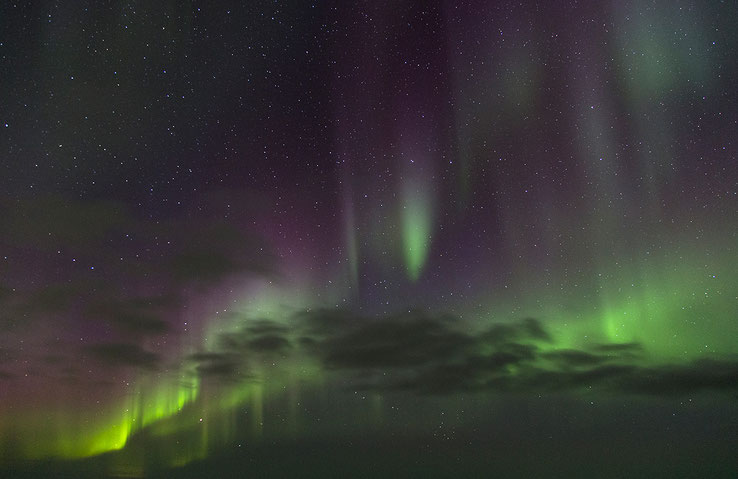
The color of the Aurora Borealis varies from green (Oxygen) to purple colors (Nitrogen) depending with atoms in our atmosphere are being stimulated by the solar wind.
Die Farben der Aurora Borealis können zwischen grün (Sauerstoff) und violett (Stickstoff) variieren, je nachdem welche Atome durch den Sonnenwind zum Leuchten angeregt werden.
Exposure Details / Aufnahmedaten
Canon EOS 1Dx
Canon 24-105mm EF 1:4 L IS USM @ 24mm
20 s
f/4
ISO 2500
Tripod / Stativ
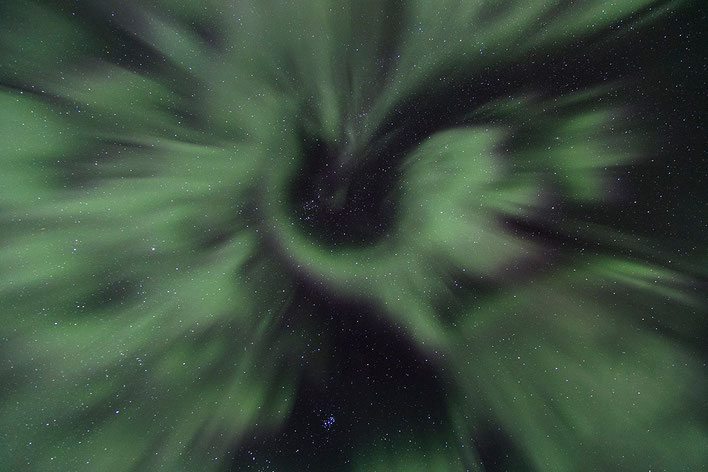
During the maximum of Solar activity (occurring every 11 years) the Aurora Borealis can be very intense resulting in pictures like this. The star cluster in the lower section of the picture is the Pleiades in the star constellation Taurus.
Während des solaren Maximums (in etwa alle 11 Jahre) kann sich die Intensität der Aurora Borealis verstärken, wie in diesem Bild zu sehen. Bei der Gruppe heller Sterne in der unteren Bildhälfte handelt es sich um den offenen Sternhaufen der Plejaden im Sternbild Stier.
Exposure Details / Aufnahmedaten
Canon EOS 1Dx
Canon 24-105mm EF 1:4 L IS USM @ 24mm
20 s
f/4
ISO 3200
Tripod / Stativ

Kommentar schreiben